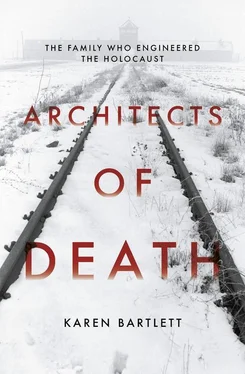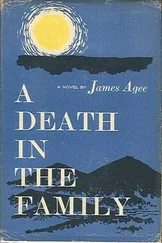Together with Auschwitz, Buchenwald and Dachau, the concentration camp at Mauthausen would make up a quartet of Prüfer’s major SS clients and would play an important part in his plans right up until Germany’s final moment of surrender. Mauthausen had been conceived as a ‘Grade 3’ camp for prisoners the Nazis considered impossible to ‘rehabilitate’ – and conditions were especially brutal. With an extremely high death rate, approximately half of the 200,000 people incarcerated there were murdered. Chosen for its proximity to several granite quarries, prisoners were often assigned to a ‘penal company’ for a trivial, or non-existent, reason and forced to carry 50 kg stone blocks on a wooden frame attached to their backs up the ‘stairs of death’ – while being beaten by guards. Many were pushed to their deaths over the top of the cliff, a practice known as ‘parachuting’ by the SS. The death rate at the sub-camp Gusen, which had three stone quarries and several industrial plants including one for Messerschmitt aircraft parts, was even worse. Mauthausen’s commandant, Franz Ziereis, conducted the first experiments in gassing prisoners by driving a converted lorry, disguised as transport for sick prisoners, between the two camps. Thirty sick prisoners would be loaded inside at Mauthausen. Ziereis would then drive to Gusen, and the prisoners would be gassed with Zyklon B en route. Upon arrival at Gusen the dead bodies would be removed, and thirty more sick prisoners would be loaded and murdered on the return drive to Mauthausen. By the autumn of 1941, Mauthausen began building a static gas chamber and started gassing Soviet prisoners of war in the spring of 1942. Gusen never had a separate gas chamber, but gassed prisoners inside locked barracks.
Auschwitz was, therefore, far from being the only concentration camp where Topf and Sons plied their horrible trade – and, at first, it was probably not obviously different to other camps that Topf and Sons had secured contracts with. Annegret Schüle reminds us:
In 1941–1942 nearly 4 million Jewish men, women and children, mainly from eastern Europe, were murdered in places other than Auschwitz. All the same, Auschwitz was the apogee of extermination by the million, a place where the SS was constantly looking for ways to simplify the murder method, speed up the murder, and perfect the technical methods for hiding the evidence. [77] Schüle, op. cit., p. 136. AS Footnote 252: Hilberg, Raul, Vernichtung der europäischen Jüden [ The Destruction of the European Jews ], Frankfurt am Main, 1999 (first published 1982; English edition 1961), vol. 2, p. 934.
Auschwitz evolved from a backwater camp for Polish prisoners to a site for Soviet prisoners of war and finally into a vast forced labour complex and the heart of the planned extermination of the Jewish race in Europe. And far from being mere ‘camp suppliers’, it was the innovation and flexibility of Topf and Sons that enabled this transformation.
The first Topf and Sons double-muffle oven was installed at Auschwitz in August 1940. It was located in what was later called Crematorium I in the main camp, a former ammunition depot half-buried underground. The death toll at the camp rose quickly, however, and soon a second oven was required. As they would for the duration of the camp’s existence, the SS panicked when they realised their facilities could not cope with the ever-increasing number of corpses.
‘The SS new-build management has already informed you by telegram that the first oven installation has already developed faults owing to high use,’ SS Oberscharführer Walter Urbanczyk wrote to Topf and Sons on 8 January 1941. ‘It is therefore absolutely vital that work on extending the system is begun. The start of the work… must not under any circumstances be delayed.’ [78] Schüle, op. cit., pp. 137–8. AS footnote 260 (on p138): Ur/T, 8.1.1941. Re: Extension to the crematorium at the Auschwitz concentration camp o/S, ThHStAW, Collection Jean-Claude Pressac Nr. 6, sheet 180; Buchenwald Memorial Archive Pressac Collection, sheet 121. [My best guess is that the ‘Ur/T’ will be the SS internal reference: Ur = Urbanczyk, T probably the initial of the typist.]
Topf and Sons installed a second double-muffle oven at the same site in February 1941, but, even with the extra capacity, it was not enough and Topf and Sons installed a third double-muffle oven in May 1942.
These first ovens were intended for the Polish and Soviet victims of Auschwitz, who were often murdered, or had died of disease. By the autumn of 1941, however, Auschwitz was beginning the final stage of its transformation. Prisoners were now being gassed with Zyklon B in the corpse room of Crematorium I that had been sealed and turned into a gas chamber. At the same time the SS had ordered the expansion of the camp by building Birkenau.
From the beginning, the SS assumed that high numbers of prisoners at Birkenau would die. The camp was originally intended for Soviet PoWs, and the Nazis had already drawn up plans that demonstrated killing millions of Soviet citizens would free up land and resources for German expansion. Therefore, following this rationale, these first Soviet prisoners of Birkenau could simply be worked to death – and disposed of in new Topf and Sons’ ovens ordered for the task. Ultimately, of course, the expansion of Birkenau did not proceed along these lines, and the camp instead became the final destination for Jewish families. But, in either case, the requirement for the mass disposal of bodies remained.
On 4 November 1941, Ernst Wolfgang Topf signed a document confirming that Topf and Sons would supply ovens for the new camp. In this letter to the SS, quoted in Chapter Two, he explains that the oven chambers are larger – improving efficiency – and that the company has taken into account that ‘some of the bodies to be cremated will be frozen’, requiring more fuel and producing more ‘gaseous waste’. The SS should ‘rest assured’, he adds, ‘we shall supply an appropriate and well-functioning system’. [79] Schüle, op. cit., p. 142. AS footnote 287: Topf and Sons to the SS Construction Management Dept, Auschwitz, 4 November 1941, Russian State Military Archive, Moscow, Special Archive Division, 502- 1-313, sheets 81–3; copy in ThHStAW, Collection Jean-Claude Pressac Nr. 6, sheets 81–3; Buchenwald Memorial Archive Pressac Collection, sheets 221–3.
Kurt Prüfer, who is no longer on commission, sees this opportunity to ask for a one-off bonus – pointing out that he worked on the ‘ground-breaking’ design in his own free time.
By now Topf and Sons are well-known for supplying concentration camps with cremation ovens, with another contract in place. Just as before, though, the execution of that contract is fraught with delays, uncertainty and alterations.
The SS originally plan to build the new crematorium behind Crematorium I in the Auschwitz main camp – even though that means transporting bodies two miles from Birkenau. By February 1942 it appears that Hans Kammler, the SS officer in charge of the new camp at Birkenau, has realised the problems this poses and decides instead to build the new crematorium at the end of a railway siding in the Birkenau camp itself. There is little urgency to actually begin work, as there are far fewer Soviet prisoners than expected. Within months, though, the plan has changed again. As outlined in the previous chapter, the Nazi regime is now committed to the total extermination of the Jews and 1942 will become the bloodiest year of the ‘Final Solution’.
In a telex to the inspector of concentration camps, SS Brigadeführer Glucks, Heinrich Himmler writes: ‘Now that we are no longer expecting Russian prisoners of war in the immediate future, I shall send a large proportion of Jews and Jewesses who have been expelled from Germany to the camps.’ [80] Schüle, op. cit., p. 155. AS footnote 14: ThHStAW, Collection Jean-Claude Pressac Nr. 41, sheet 33; Buchenwald Memorial Archive, Pressac collection, sheet 314.
Читать дальше












